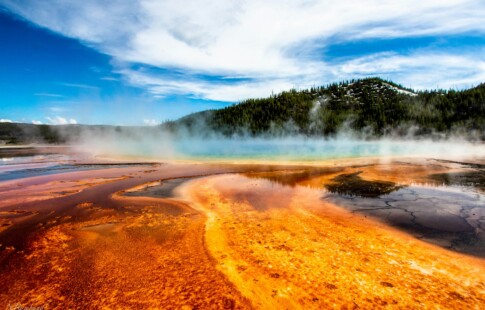
How Allergies and Climate Change Connect
We are reader-supported. When you buy through links on our site, we may earn affiliate commission.
Anyone keeping up with current events knows how the negative effects of climate change are already affecting the planet and human health. Some signs of climate change include severe droughts, raging wildfires, rising sea levels, life-threatening natural disasters and melting glaciers.
Aside from environmental changes, the climate crisis is expected to impact human health. Significant environmental changes could exacerbate existing human health problems and new health threats will emerge.
One common health issue that could worsen and impact a large portion of the population is seasonal allergies. How are seasonal allergies and climate change connected?
What Triggers Seasonal Allergies?
According to the CDC, approximately 60 million Americans suffer from seasonal allergies every year. Some of the most common symptoms of seasonal allergies include runny nose, itchy and watery eyes, sneezing and nasal/sinus congestion.
Various triggers can spark seasonal allergies. Some examples of airborne allergens are pollen, dust mites, pet dander and mold. Pollen is widely known as one of the most common allergens. It consists of tiny seeds of flowering plants, grasses and trees. When the wind carries the seeds throughout the environment, it can cause people to suffer from seasonal allergy symptoms.
How and Why Does the Body React to Pollen or Other Allergens?
When an allergen enters the immune system, the body reacts as if it’s a dangerous invader when in reality, it’s a harmless substance. Then, the immune system produces antibodies for that specific allergen. When someone is exposed to the allergen again, the antibodies release several chemicals into the body, like histamine, which causes the symptoms of seasonal allergies.
People with asthma are also more prone to having asthma attacks during allergy season. Increased pollen levels in the environment can impact asthmatic people and those whose pollen triggers their asthma.
Additionally, seasonal allergies are inextricably linked to other respiratory problems. They can have consequences, including increased risk for viral infections and emergency room visits and might even impact a child’s performance in school.
Research Suggests Pollen Season is Worsening
Because the root of most seasonal allergies is pollen, it’s understandable that changes in pollen season will influence the severity of people’s seasonal allergies and how long they deal with physical symptoms.
Many people with allergies dread changes in seasons, especially when it’s becoming warmer outside. In many areas of the U.S., people will experience seasonal allergies beginning in February and lasting until the early summer. In warmer tropical climates, grass pollinates throughout the year so some individuals will experience symptoms at different times.
If you or someone you know suffers from seasonal allergies, you may believe that allergy season lasts a bit longer each year. According to a study by William Anderegg and a team of researchers from the University of Utah School of Biological Sciences, human-caused climate change is significantly impacting the lengthening of pollen season.
Here are some of the key findings from the team’s research:
- Nationwide pollen amounts increased by 21% during the study period
- The greatest pollen increases were in Texas and the Midwestern U.S.
- Pollen season starts around 20 days earlier and lasts 10 days longer than it did in 1990
- Warmer temperatures cause plants’ internal timing (a.k.a. phenology) to begin producing pollen earlier in the year
These findings indicate that allergy seasons have worsened in the last few decades. More people will suffer from seasonal allergies when more pollen is in the air for a longer period.
How Climate Change is Impacting Pollen Season
To make the connection between longer, more severe allergy seasons, the team at the University of Utah also applied statistical methods to pollen trends in conjunction with almost 24 climate models.
The results were telling, as they suggested that climate change could account for about half of the lengthening of pollen season and 8% of the increasing amount of pollen in the environment. After researchers split the study into two periods—1990-2003 and 2003-2018—they found that climate change is contributing to the acceleration of increasing pollen amounts.
Other Health Effects Brought About by Climate Change
Ongoing environmental issues can cause other physical and mental health problems for people in the impacted regions.
Environmental pollutants can cause respiratory problems, some types of cancer and heart disease. Low-income communities might be located in areas with polluted water sources, making drinking water supplies unsafe. Children and pregnant women are two vulnerable populations because they’re at a higher risk of adverse health effects related to pollution.
As for mental health, high carbon emissions increase heat production in the atmosphere, causing temperatures in some areas to rise, especially in the summer. Individuals are confined indoors when it’s too hot to go outside due to the increased risk of heatstroke. Excessive time spent indoors can cause people to experience anxiety and depression because of the lack of outdoor exercise, feelings of isolation and poor mood.
Basic Tips for Treating Seasonal Allergies
Because people with seasonal allergies may experience more frequent or severe symptoms as climate change continues, they must know how to take care of themselves.
Here are some helpful tips for allergy-sufferers when their symptoms become bothersome:
- Stay indoors on dry, windy days to avoid being exposed to pollen.
- Avoid activities like lawn mowing, weed pulling or gardening to avoid stirring up pollen.
- Start taking OTC allergy medications if the pollen count is high in your region
- Use air conditioning in your home and car.
- Keep your home clean to reduce the number of dust mites and pet dander.
- Use a portable, high-efficiency particulate air (HEPA) filter to improve indoor air quality (IAQ).
- Try other OTC remedies, including antihistamines, nasal sprays, oral decongestants, saline solution nasal rinses, etc.
Often, people wake up one day and immediately feel their seasonal allergies taking over, with frequent sneezing, a runny nose, itchy eyes or congestion. As soon as someone experiences symptoms, they should remember the tips above to relieve symptoms and get back to feeling better.
Allergies and Climate Change: Will Continue Affecting Human Health
Many Americans deal with seasonal allergies, meaning that millions of people know what it’s like to sneeze, feel congested, have itchy eyes and have a runny nose during certain times of the year. Because climate change is significantly affecting the environment, it’s understandable that it will directly affect the plants, grasses and trees that cause increases in allergens in the atmosphere.
There’s a strong case to fight climate change and take action against it. Despite worsening allergy seasons, this fact alone is not enough to spark any major changes in climate policy. Anyone suffering from seasonal allergies should be aware that future allergy seasons might be longer and could worsen allergies as time passes. It will be interesting to see how the connection between seasonal allergies and climate change evolves.
Share on
Like what you read? Join other Environment.co readers!
Get the latest updates on our planet by subscribing to the Environment.co newsletter!
About the author

Steve Russell
Steve is the Managing Editor of Environment.co and regularly contributes articles related to wildlife, biodiversity, and recycling. His passions include wildlife photography and bird watching.





